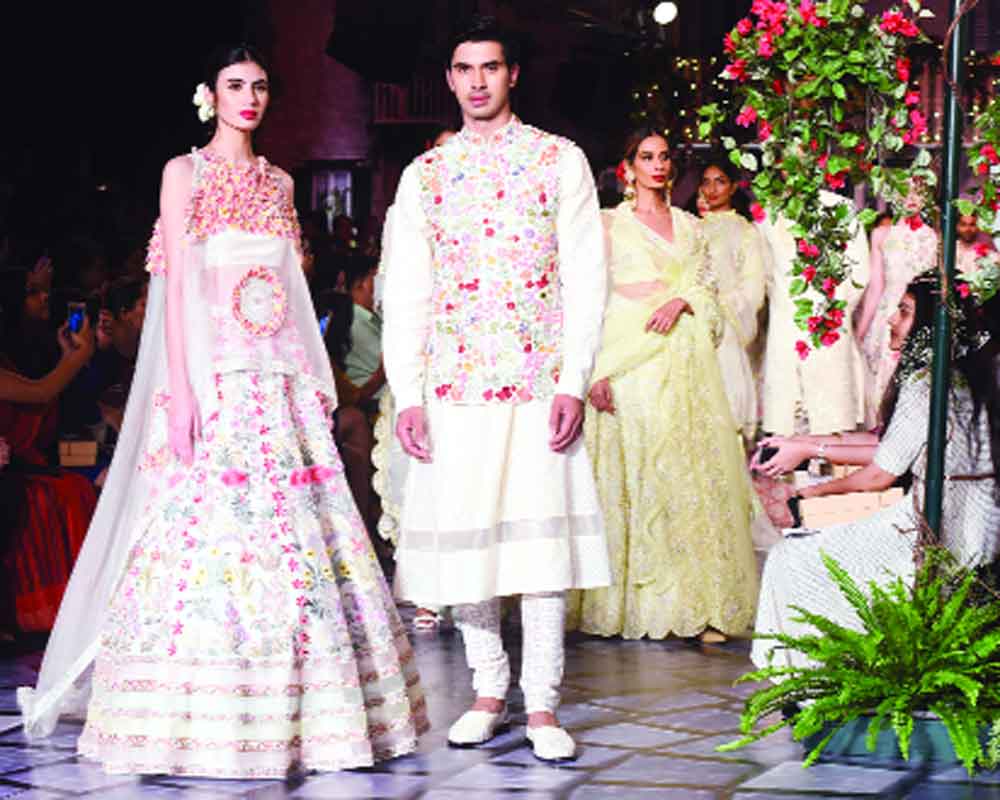Designer Rahul Mishra takes inspiration from the French city of Monaco and his hometown Malhausi for his couture collection. His ensembles, which are rendered in organza and muga silk, bring forth a dense play of floral in 3D motifs and intricately-embroidered appliques, says Chahak Mittal
Picture this: trimmed trees, arched bridges, classic French wooden windows covered with vine creepers, red hibicuses in baskets hung below street lamps, white benches placed next to houses, European paintings on red-bricked walls, long walks on the black-stoned streets of the Grimaldi and Fontvieille. No, this is not a travelogue where we have been transported to the playground of the rich and famous, rather a vignette of the sight at designer Rahul Mishra’s couture collection show at FDCI’s India Couture Week 2019. It romanced the words, ways and wonders of the French-Riviera city, Monaco and at the same time combined it with the designer’s childhood memories of his hometown, Malhausi. The show proved models wearing heavy couture can not only walk stunningly but ride bicycles as well on it and nail it. The set’s Monaco-like design was a result of the designer’s close professional relations with wedding planner Vandana Mohan and her daughter Vedika.
So how did the city inspire him? He said, “There’s a famous saying that goes, ‘One often finds himself when one goes away from his usual surroundings’. And my travel to Monaco last year did exactly that. It made me plan this collection. I began working on it in November 2018 after we had a show there. There, I looked at the flowers, trees, the greenery around, paintings and walls and to me, the city looked like a beautiful landscape. It inspired me hugely. It was almost like the idea of shining a light on the world. That is why I was very happy after showcasing in Monaco.”
Post that he was approached by Visit Monaco as they were “very happy” with Rahul’s work and wanted to collaborate with him. “And that’s how it all started. And also, for me, while I am presenting here or in Paris, there is a line of similarity and that is what I get most excited about. The response to these looks in Paris was very good. So I wanted to present it back at home. Although it was a new journey to transform a ‘short’ Western dress that I had showcased in Paris into something which fits into the idea of the Indian couture, say a ‘gherdaar’ lehenga,” said he.
With a dense play of floral and 3D motifs, and intricately-embroidered appliques, the collection saw anarkalis with jackets, lehengas, saris with gowns and dupattas, Nehru jackets for men, kurta and churidaars, and strapless gowns in white, mild green and icy pink. The stunning ensembles were rendered in “a lot of” organza, muga silk in glossy texture and silk crepe. The designer said that the collection is beyond any design techniques, methods or fabrics. “It was not about what motifs or fabrics I have used because there were hardly any references taken from any book or paintings or even anything from the history. Everything came very naturally, from within me. I reflected here upon my childhood and everything that I have dreamt of. It was all coming from me and what I had experienced,” he added.
He referenced Claude Monet, who had said, ‘I want to paint the air in which the bridge, the house and the boat are to be found including the beauty of the air around them, and that is nothing less than impossible.’ Upon reading such words, he finds himself moved by the magnitude of emotion in his art. “It rises to a degree where the feeling while creating is the most important rather than the creation itself. And this is why I feel artists are like stars, who are an unending source of light and we are like planets who borrow light from them to fuel our imagination,” explained he.
So what’s Indian couture fashion and silhouettes for him? “Silhouettes for me aren’t different for men or women. It’s universal. Because ultimately, when you look at women’s clothes, it’s already a hundred-year-old phenomenon, where Chanel thought how can women’s clothing be made something into a larger-than-life idea. In the same way, when you look at Mughal men, they are all wearing the gherdaar and anarkali kind of attires. So I find them very stereotyped in the modern dictionary. There shouldn’t be any differentiation between men’s and women’s style of clothing,” he said.
Due to the changing lifestyles, he added, “today, our routines have also brought in a change in the way we dress up. So in that way, clothing is not just confined to something that we use to cover ourselves anymore, it has become a comfort, a statement and our very style.”
Photo: Pankaj Kumar


























